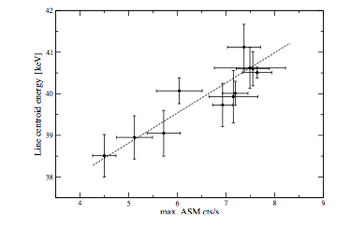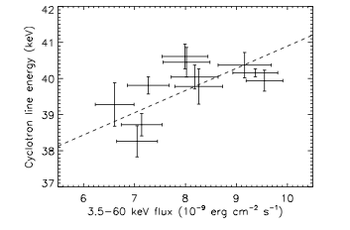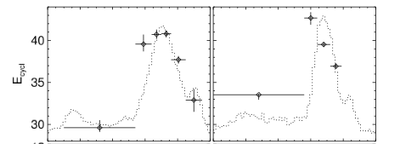Hercules X-1
!!!!!!!!!!!!!!!!!!!!!!!!!!!!!
Based on D.Vasco's PhD thesis
!!!!!!!!!!!!!!!!!!!!!!!!!!!!!
System Overview
| Parameter | Value | Unit |
|---|---|---|
| Porb | 1.7 | days |
| Pspin | 1.24 | s |
| Neutron star mass | ~1.5 | M⊙ |
| Companion mass | ~2.3 | M⊙ |
| Inclination | ~85-88 | deg |
| Lx | 2×1037 | erg s-1 |
| a sin i | 13.183 | lt s |
(Main) Observational Properties
The system Her X-1/HZ Her presents several phenomena which occur at different timescales. The main properties of the system are summarized below:
- The 35 day modulation of the X-ray flux;
- The systematic variation of the pulse profile as function of the 35 day phase and energy;
- The cyclotron absorption feature in the X-ray spectrum and its positive correlation with the bolometric luminosity of the source;
- The systematic variation of the cyclotron line energy with pulse phase.
The 35 day cycle
This modulation, originally known as the "35 day on-off cycle", is very well-known since the discovery of the system and it was attributed to the counter-clock precession of a tilted and twisted accretion disk which covers temporarily the X-ray emitting region. Because of the changing in the obscuration of the neutron star, the emission region is occulted, totally or partially, by the accretion disk. This leads to a clear modulation of the X-ray flux as function of the precession of the accretion disk. Within this modulation it is possible to identify two on-states at those 35 day phases where high X-ray flux is detected. These two on-states are separated by two off-states in which the X-ray flux is very low or even not detected. Even more interesting is the fact that the on-states are of two different types: Main-On and the Short-On. The necessity to distinguish the two on-states comes from the difference in X-ray flux (and because of different pulse profiles). The flux of the Main-On is higher than the flux of the Short-On by a factor of four to five. The transition between the off-state and the Main-On is called turn-on and it is used to count the 35 day cycles.
Picture taken from Jones at 1976.
The pulse profile variation
The system shows a systematic and repeating variation of the pulse profiles shape as function of energy and time. Each 35 day cycle, the same evolution of the pulse profile shape is observed. This is a unique scenario among X-ray accreting pulsars and, it is known since the discovery of the system. The variation of the pulse profile with energy is quite common for X-ray pulsars, but the systematic changes with precession phase are noticed only in Her X-1. These changes are reflected in a variation of the individual components of which the X-ray pulse profile consists. The typical double-peaked structure of the Her X-1 pulse profile varies into a single peak structure with an increase of energy or precession phase. Other smaller changes are also observed for the interpulse component.
Pictures taken from Scott et al. 2000.
Cyclotron line energy / luminosity correlation
Her X-1 was also the first X-ray accreting pulsars for which a Cyclotron Resonance Scattering Feature (CRSF) was discovered (Truemper et al. 1978). This absorption-like feature is observed around 40\,keV and played a key role in the estimation of the magnetic field of neutron stars. In fact, using the formula B_12 = (1+z) E_cyc/11.6 keV (where B_12 is the magnetic field strength in units of 10^12 Gauss, z is the gravitational redshift and E_cyc is the energy of the cyclotron line; see e.g. the book of Lipunov 1987, the first direct measurement of its magnetic field was found. The source shows a positive correlation between the centroid of the cyclotron line energy and the bolometric luminosity (Staubert et al. 2007, Vasco et al. 2011). This is a unique scenario, because other studies on bright, super-Eddington transient pulsars such as V0332+53 and 4U 0115+63 have shown the opposite behavior (Mihara et al 1998, Mowlavi et al. 2006, Nakajima et al. 2006). This is believed to be due to a transition between two different accretion regimes. For high luminosity transients, when the accretion rate increases, the height of the radiative shock above the neutron star increases as well, leading to a decrease of the magnetic field strength, which is reflected in a decrease of the cyclotron line energy (Tsygankov et al 2006). On the other hand, in the sub-Eddington regime, as in the case of Her X-1, the scattering region is located closer to the neutron star surface because of the dynamical pressure of the infalling material which pushes down this region. This leads to an increase in the magnetic field strength and an increase in the observed cyclotron line energy (Staubert et al. 2007).
Pictures taken from Staubert et al. 2007 and Vasco et al. 2011, respectively.
Systematic variation of the cyclotron line energy with pulse phase
Her X-1 shows a systematic variation of the centroid of the cyclotron line as function of the pulse phase. Pulse phase resolved spectroscopy analyses have been performed over the years with different instruments (see e.g. the latest by Klochkov et al. 2008). The centroid of the cyclotron line follows the shape of the pulse profile: higher values of the cyclotron line are observed at those phases corresponding to the pulse peak, and lower values at the rest of the pulsation.
Picture taken from Klochkov et al. 2008.





